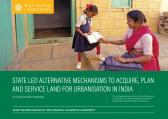
This document describes and analyses six state-led alternative mechanisms that provide an end-to-end area development approach that enables land acquisition, it's planning, and servicing, as well as methods to capture the land’s increased value to help pay for basic infrastructure and social amenities.
A case was selected for each type of mechanism that demonstrated this end-to-end area development approach. The provisions and processes in the legal frameworks of each mechanism were analysed along with experiences from secondary sources regarding its impact, strengths, and challenges.
Through an extensive literature review, nine parameters were derived that assess the equity and efficiency of each mechanism. The legal frameworks and other statutory documents that describe the six cases were analysed based on these parameters. Key findings and recommendations are presented on how to strengthen the six mechanisms as well as how it measures up against the nine parameters. Further research needs are also proposed.
State and city authorities seeking to develop alternative mechanisms to acquire, plan, and service urban land using value capture methods should find this study useful. It can assist in knowledge sharing, informed decision-making, and legislative amendments for the contextually appropriate use of alternative mechanisms. It will also be of interest to private developers as well as researchers who are directly or indirectly involved in such processes. This study seeks to fill a gap in the public domain for a single document that details and compares state-led alternative mechanisms to plan and service land in infill areas, urban extensions, and greenfields. There is currently a lack of easy access to collated information on the process of these mechanisms, let alone any analysis of them.
To view the full paper paper, click here.
To view the illustrated executive summary, click here.
For more information, please write to Rejeet at RMathews@wri.org.
